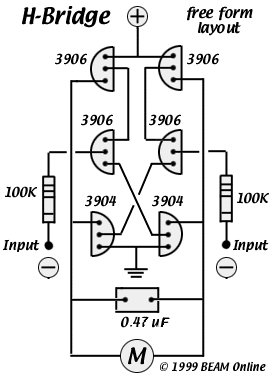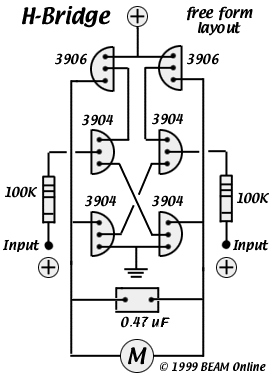|
|
The BEAM Circuits Collection is a BEAM Reference Library site.
Mark Tilden's 6-transistor
H-bridge
Design, limitations,
usage
This is the six transistor "Tilden style" H-bridge; while not as old as the original "basic H-bridge," this goes "way back," and is the basis for many BEAM driver circuits
- Up to 800 mA capacity (using PN2222 and PN2907 transistors)
- 30 connections per bridge (so, 30 holes if you make a PCB)
- Not "smoke-proof" (i.e., it can't handle drive voltage in both directions at once)
You can read the original Tilden article (complete with ASCII art) here.
This circuit comes in two flavors -- one triggers on positive input (non-inverting), the other triggers on negative input (inverting).
Freeforming
Courtesy of Bruce Robinson, here are diagrams for
free-forming both the inverting and non-inverting flavors of
this circuit (note that these are drawn "dead bug" style,
i.e., with leads "up"):


Bruce Robinson explains:
I did a couple of revised drawings for Ian quite a while back, so he could put them up at beam-online. Unfortunately, they didn't get posted in the midst of the many revisions he was making.Attached (begging Ian's indulgence), are the two versions of the circuit, one which turns on with a Positive input, the other (for quadcores) with a Negative input.
Ian shows 100k input resistors. I've been using 47k resistors successfully. Tilden's article recommends nothing lower than 50k (I assumed 47k was close enough) and up to 20 Meg or so.
I've also noticed a slight drop in speed when I use these bridges, but only about 10% or so.
|
|
|
Math Vos has a page
with a different layout for this circuit. |
|
|
||
|
|
This page was last updated on |
|